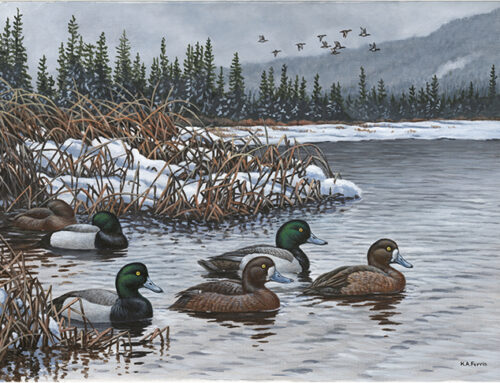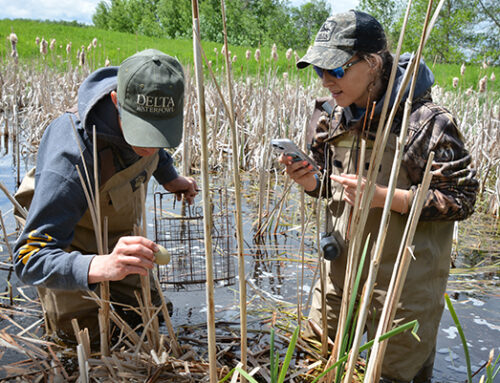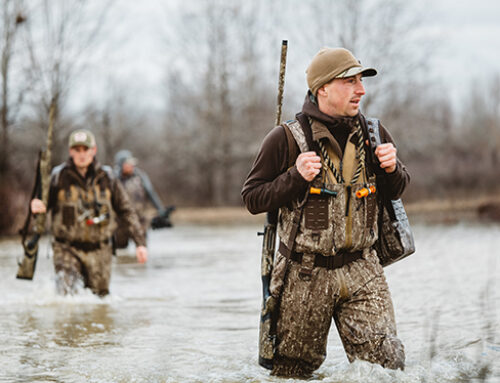Duck Numbers are Fifth-Highest on Record

By Kyle Wintersteen
Another strong fall flight is ready to wing south.
 The 2017 Waterfowl Breeding Population and Habitat Survey puts the spring duck population at 47.3 million birds, the fifth-highest tally ever, and just the 16th time the estimate has exceeded 40 million. The annual survey, which has been conducted jointly by the U.S. Fish and Wildlife Service and Canadian Wildlife Service since 1955, indicates a minimal decrease from last year’s population of 48.4 million, but the estimate remains 34 percent above the long-term average.
The 2017 Waterfowl Breeding Population and Habitat Survey puts the spring duck population at 47.3 million birds, the fifth-highest tally ever, and just the 16th time the estimate has exceeded 40 million. The annual survey, which has been conducted jointly by the U.S. Fish and Wildlife Service and Canadian Wildlife Service since 1955, indicates a minimal decrease from last year’s population of 48.4 million, but the estimate remains 34 percent above the long-term average.
“The duck numbers remain really strong,” said Dr. Frank Rohwer, president and chief scientist of Delta Waterfowl. “Most duck populations remain near or above long-term averages.”
Overall, four of the 10 key index species increased, and all but pintails and bluebills are above long-term averages. The 2017 survey marks the highest estimate ever recorded for gadwalls, which climbed 13 percent to 4.18 million birds, putting them 111 percent above the long-term average.
“That’s great news for hunters, especially in the southern United States where the gadwall has become an increasingly important species,” said Rohwer.
Waterfowlers should also be encouraged that pintails increased 10 percent to 2.89 million. While they remain 27 percent below the long-term average, the estimate snaps five straight years of declines.
“Isn’t it great to finally have some good news to report about pintails?” Rohwer said. “I expect the estimate is high enough that hunters will be blessed with a two-pintail daily limit for the 2018-19 season. The birds increased due to the way water was distributed across the prairie this year. The pintails’ preferred breeding range — southern Alberta and southern Saskatchewan — provided ample shallow wetlands. I also anticipate pintail production to be substantially improved over last year, when they overflew the dry prairie and went to the arctic, where production is always low.”
The 2017 survey further indicates that the blue-winged teal population grew by 18 percent to 7.89 million — the species’ fifth highest estimate in history — 57 percent above the long-term average. Additionally, northern shovelers climbed 10 percent to 4.35 million, 69 percent above the long-term average.
“Like pintails, bluewings and shovelers really responded to all of that water in southern Canada,” Rohwer said.
Among the survey’s less encouraging results, mallards declined 11 percent from last year’s record high to 10.49 million, but remain 34 percent above the long-term average.
 The largest percent decreases were observed among wigeon and green-winged teal, which fell 19 and 16 percent, respectively. Still, wigeon remain 6 percent above the long-term average, while greenwings are still in great shape at 70 percent above the long-term average.
The largest percent decreases were observed among wigeon and green-winged teal, which fell 19 and 16 percent, respectively. Still, wigeon remain 6 percent above the long-term average, while greenwings are still in great shape at 70 percent above the long-term average.
Attention diver hunters: Redheads and canvasbacks remain well above long-term averages, despite a 13 percent decline among redheads and a minimal decrease in cans. The news is less promising for scaup, which fell 12 percent to 4.37 million, 13 percent below the long-term average.
The May pond count registered 6.01 million — 22 percent higher than last year and 17 percent above the long-term average. Pond counts in prairie and parkland Canada, which covers Alberta, Saskatchewan and Manitoba, increased 24 percent, 23 percent above the long-term average. Pond counts in the North-Central United States, which covers Montana and the Dakotas, are up 22 percent, 17 percent above the long-term average.
However, nesting conditions in the U.S. prairie were significantly better in May as the surveys were conducted, before drought impacted a vast number of wetlands.
“I think the pond count is a little misleading, because wetlands in the Dakotas and parts of the southern Canadian prairies dried out quickly and dramatically following the surveys,” Rohwer said. “Renesting and brood survival are going to be far lower this year. I don’t expect the production we’ve seen in recent years.”
That’s important for hunters, who shoot the fall flight, not the breeding population.
“We will see a lot of birds flying south, but it’ll be more challenging for hunters because the flight will have a higher percentage of adult ducks,” Rohwer said. “Juvenile birds are much easier to decoy.”






Leave A Comment